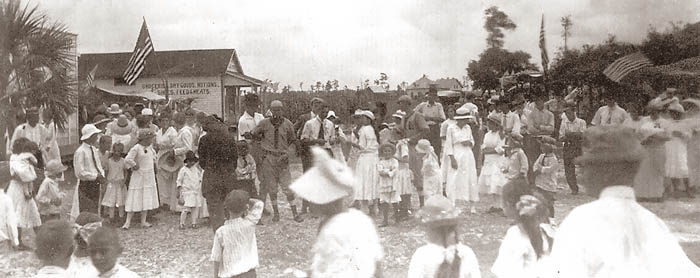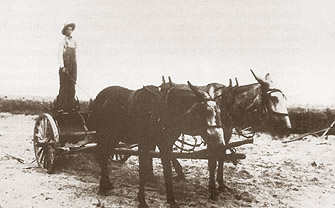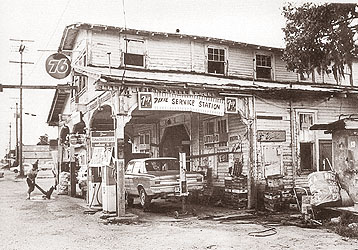|
The History of Lutz - Page 9 |
|
Read the left and right panes before scrolling down to the next levels. Click links to view related photos, use your back browser button to come back to this page. |
|
Click on links in text, they lead to more pictures |
||
|
The Advent of the Automobile Brings Road Improvements to Lutz |
||
|
In 1914 Lutz had the look of many small American towns before the coming of the automobile. The center of town was bounded on the north by Vernon Rd, on the east by the Tampa Northern RR, on the south by Palm Avenue (First Ave. SW), and on the west by First St. SW. Within that area a bandstand was built so that the Lutz city band (formed in 1913) could perform in these pre-radio days. Concerts were held there on Sunday afternoons, and special occasions such as July 4th. |
Walking west from the bandstand to First Street SW, residents would pass George Polen's general store, Dr. W. J. Hood's "Golden Rule" store, and attached to it Evans' Barber Shop. Walking south to Palm Avenue (First Ave. SW) they would have passed a two-story building that was originally North Tampa Stores and possibly another building, Chambers Store. Then counterclockwise to the east, the old bed of the Tampa and Gulf Coast RR, the train depot, Guy Sparlin's Railroad Restaurant, and the Tampa Northern Railroad tracks. |
|
|
As local residents began to purchase cars, the demand for better roads escalated. The first cars in the area were Model T Fords, owned by Mary Newberger Feinsinger and Mike Riegler. The Newberger's property was just south of Newberger road at the west end where it meets US 41. The Feinsingers lived just east of there. |
In 1916 Lutz held their 4th of July celebration in the center of town, which included a baseball game. Lutz and Odessa, like other communities, had their own town teams. See the 1916 team
See 4th of July women's race, circa 1910's.
|
|
|
July 4th, 1916 celebration. George Polen's store can be seen at the left, behind the flag.
|
||
|
In 1921 a 14-foot wide asphalt brick road was built on the sandy road that paralleled the tracks from Sulphur Springs (8 miles south of Lutz) along Nebraska Avenue, extending Nebraska Avenue in Tampa through Lutz to the Pasco County line. L. B. Smith and his brothers used their father's mules, a wheeler-scraper and a scoop to grade the road bed. The Smiths employed workers to help with the grading, and hard laborers to lay the asphalt brick paving.
Because mules were used in this work, they kept a pen of 40 animals in Stemper where they lived. When the Smiths worked at Bearss Avenue, they moved the pen there. |
L. B. Smith in 1921, driving the wheeler-scraper to grade the road bed of S.R. 5 (now US 41) before the asphalt bricking is laid. North of the county line the road was limestone and gravel. |
|
|
The asphalt bricking widened the sand road through Lutz, prompting businesses to move east of the road. One such business was the old Sparlin Railroad Restaurant building; it was moved from north of the depot directly across the highway. Then owner Dave Keen, who was blind, sold a few groceries and notions at the new site. |
South of Keen's was the Lutz Garage owned by Jack Denison, a restaurant also owned by Denison (his family lived in the rear of the building), Kit Carson's pool hall, and a grocery and feed store run at one time by Pete Denison and his mother Martha Ann Floyd. Later it was operated by W. D. Coates, the local grocer for many years, then Glen Andrews and Al Crandon until Pardo and Prieto bought the business. They ultimately moved it into a new block building known as the "Lutz Superette."
L to R: Dave Keen's store, Jack Denison's garage, Mrs. Denison's Lutz Inn, Kit Carson's pool hall, W.D. Coates' general store. |
|
|
In the early 1920's, south of First Ave. SE was the H & N Garage (reportedly stood for Helveston & Newberger.) Later it became the Dixie Service Station run for many years by Bill Steinke.
The Dixie Service Station was a combination garage, gas station and gossip haven. Anyone wanting to catch up on what was happening in Lutz needed only to come in, grab a soft drink from the box, and pull up a wooden crate, sit down and keep their ears open. The building was torn down in 1973. |
||



